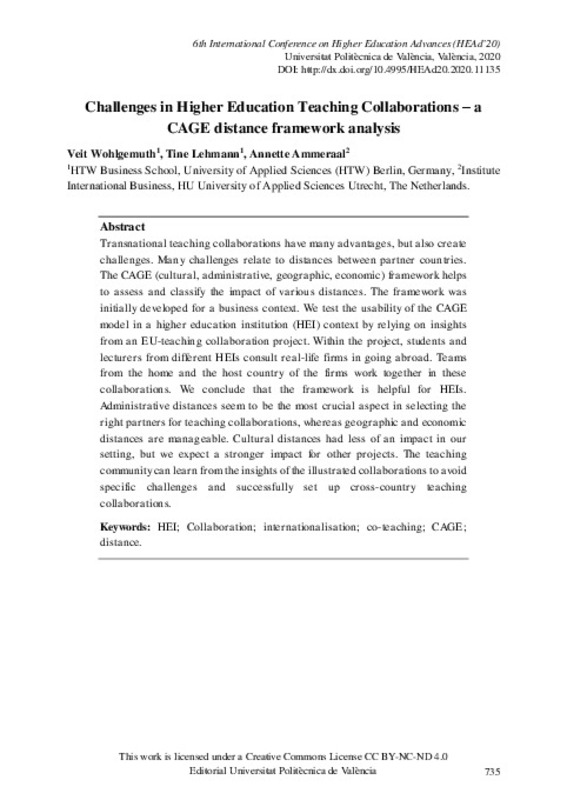JavaScript is disabled for your browser. Some features of this site may not work without it.
Buscar en RiuNet
Listar
Mi cuenta
Estadísticas
Ayuda RiuNet
Admin. UPV
Challenges in Higher Education Teaching Collaborations – a CAGE distance framework analysis
Mostrar el registro sencillo del ítem
Ficheros en el ítem
| dc.contributor.author | Wohlgemuth, Veit
|
es_ES |
| dc.contributor.author | Lehmann, Tine
|
es_ES |
| dc.contributor.author | Ammeraal, Annette
|
es_ES |
| dc.date.accessioned | 2020-06-12T05:58:27Z | |
| dc.date.available | 2020-06-12T05:58:27Z | |
| dc.date.issued | 2020-04-28 | |
| dc.identifier.isbn | 9788490488119 | |
| dc.identifier.issn | 2603-5871 | |
| dc.identifier.uri | http://hdl.handle.net/10251/146194 | |
| dc.description.abstract | [EN] Transnational teaching collaborations have many advantages, but also create challenges. Many challenges relate to distances between partner countries. The CAGE (cultural, administrative, geographic, economic) framework helps to assess and classify the impact of various distances. The framework was initially developed for a business context. We test the usability of the CAGE model in a higher education institution (HEI) context by relying on insights from an EU-teaching collaboration project. Within the project, students and lecturers from different HEIs consult real-life firms in going abroad. Teams from the home and the host country of the firms work together in these collaborations. We conclude that the framework is helpful for HEIs. Administrative distances seem to be the most crucial aspect in selecting the right partners for teaching collaborations, whereas geographic and economic distances are manageable. Cultural distances had less of an impact in our setting, but we expect a stronger impact for other projects. The teaching community can learn from the insights of the illustrated collaborations to avoid specific challenges and successfully set up cross-country teaching collaborations. | es_ES |
| dc.language | Inglés | es_ES |
| dc.publisher | Editorial Universitat Politècnica de València | es_ES |
| dc.relation.ispartof | 6th International Conference on Higher Education Advances (HEAd'20) | |
| dc.rights | Reconocimiento - No comercial - Sin obra derivada (by-nc-nd) | es_ES |
| dc.subject | Higher Education | es_ES |
| dc.subject | Learning | es_ES |
| dc.subject | Educational systems | es_ES |
| dc.subject | Teaching | es_ES |
| dc.subject | HEI | es_ES |
| dc.subject | Collaboration | es_ES |
| dc.subject | Internationalisation | es_ES |
| dc.subject | Co-teaching | es_ES |
| dc.subject | CAGE | es_ES |
| dc.subject | Distance | es_ES |
| dc.title | Challenges in Higher Education Teaching Collaborations – a CAGE distance framework analysis | es_ES |
| dc.type | Capítulo de libro | es_ES |
| dc.type | Comunicación en congreso | es_ES |
| dc.identifier.doi | 10.4995/HEAd20.2020.11135 | |
| dc.rights.accessRights | Abierto | es_ES |
| dc.description.bibliographicCitation | Wohlgemuth, V.; Lehmann, T.; Ammeraal, A. (2020). Challenges in Higher Education Teaching Collaborations – a CAGE distance framework analysis. En 6th International Conference on Higher Education Advances (HEAd'20). Editorial Universitat Politècnica de València. (30-05-2020):735-742. https://doi.org/10.4995/HEAd20.2020.11135 | es_ES |
| dc.description.accrualMethod | OCS | es_ES |
| dc.relation.conferencename | Sixth International Conference on Higher Education Advances | es_ES |
| dc.relation.conferencedate | Junio 02-05,2020 | es_ES |
| dc.relation.conferenceplace | València, Spain | es_ES |
| dc.relation.publisherversion | http://ocs.editorial.upv.es/index.php/HEAD/HEAd20/paper/view/11135 | es_ES |
| dc.description.upvformatpinicio | 735 | es_ES |
| dc.description.upvformatpfin | 742 | es_ES |
| dc.type.version | info:eu-repo/semantics/publishedVersion | es_ES |
| dc.description.issue | 30-05-2020 | |
| dc.relation.pasarela | OCS\11135 | es_ES |








